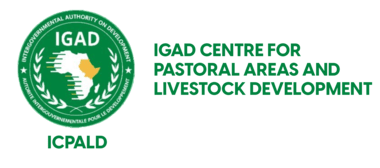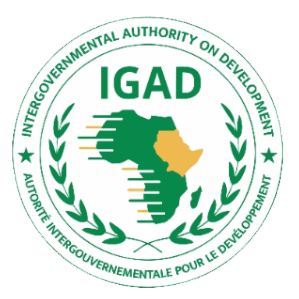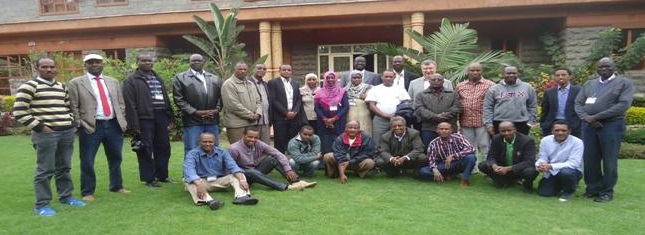The Intergovernmental Authority on Development (IGAD) and AU-IBAR have been working in collaboration to strengthen the control of animal diseases in the region, with efforts mainly targeted at the establishment of integrated regional (inter-country) coordination mechanisms for the prevention and control of TADs and zoonoses, strengthening of veterinary governance, capacity building in different areas of animal health service delivery, strengthening stakeholder engagement in policy processes and disease control; and resource mobilization to support regional integration and disease control initiatives among others.
The regional disease prioritization exercise was organized with the financial support from the EU funded Veterinary Governance Programme and used OIE tool for the “Listing and categorization of priority animal diseases including those transmissible to humans” developed through a study conducted by the French Phylum Consultancy firm.
Majority of the participants at the regional exercise had undergone training in 2013 on the OIE tool for the “Listing and categorization of priority animal diseases including those transmissible to humans” developed through a study conducted by Phylum. They were supported by senior experts from the national veterinary and public health departments, ICPALD-IGAD secretariat. AU-IBAR animal health unit and Phylum.
Objective of meeting on prioritization and categorization of animal transboundary diseases and zoonoses in the IGAD region:
The regional disease prioritization exercise was intended to support the 6 member states and ICPALD-IGAD secretariat to identify, prioritize and categorize the key transboundary and zoonoses for public policy and animal health programs. The specific objectives were:
- Assess the real or potential impact of 15 to 17 diseases at country and regional level;
- Define a short list of prioritized diseases for every member state that could be part of public animal health policy;
- Define a short list of prioritized diseases for the IGAD region that could be part of public animal health policy;
- Identify some strategic priorities to control the diseases, including the roles of different stakeholders.
- Provide evidence for decision making on policies, strategy development and appropriation of resources.
It is anticipated that the prioritization of TADs and zoonoses for the IGAD region will facilitate systematic efforts to roll back priority diseases through focused national efforts, harmonized regional strategies and streamlining of stakeholder investment in the region’s main priorities.
Summary of proceedings / Outcome
In addition to AU-IBAR and ICPALD, this meeting was attended by 6 IGAD member states; namely Djibouti, Eritrea, Ethiopia, Somalia, South Sudan and Sudan (3 participants from a MS) as Kenya and Uganda participated earlier in the first training for EAC member states. It was facilitated by a consultant from the Phylum Consultancy, Dr. Francois Gary. It is important to remind that the tool is dedicated to prioritize the disease that could justify public control programs led by Veterinary Services.
The IGAD member states and the secretariat worked on an initial list of 16 diseases Brucellosis, Bovine Tuberculosis (TB), Contagious Bovine and Caprine Pleuro-pneumonia (CBPP), East Coast Fever (ECF), Trypanosomiasis, Rift Valley Fever (RVF), Rabies, New Castle Disease, Highly Pathogenic Avian Influenza (HPAI), Foot and Mouth Disease (present and absent serotypes), Lump Skin disease (LSD), Sheep and Goat Pox (SGP), Camel Pox, African Horse Sickness (AHS), and African Swine Fever (ASF). The importance of all these diseases was assessed based on specific criteria including local economic impact, local public health impact, local societal, local environmental impact, and local feasibility, local economic and local societal & environmental impact of control measures. Assessment considered both present and absent diseases.
Every country was able to identify some priority diseases and to consider appropriate control strategies for both present and absent (or clinically absent) diseases. It is important to emphasize that the tool is dedicated to prioritize the disease that could justify public control programs led by Veterinary Services.
Rinderpest was not been included in the exercise because each country reportedly has a contingency plan and commitment to apply surveillance and to maintain contingency plan according to the OIE standards and Ebola Virus, despite it is not an animal health issue, was also included and assessed. To ensure that, in case of spread of this disease, the needed control movement of humans could jeopardize the livestock activities such as pastoral or nomadic movements, domestic and international trade and create a strong economic impact. Prevention, awareness program and contingency plan should be developed in each country with coordination; and under supervision of the Public Health Services, according to the “One Health” concept.
MERS-CoV was equally discussed as an important issue for the region and to justify current investigations on the role of the animals, especially camels, in the epidemiology of the disease and the routes of transmission to humans. Due to the lack of knowledge, this disease was not assessed within the tool dedicated to prioritize the animal health control programmes developed by the Veterinary Services. However, research activities should be supported.
Priority present diseases in MS and IGAD
| No. | MS/IGAD | Prioritized diseases | Absent diseases |
| 1 | Djibouti | 1. PPR
2. CCPP 3. CBPP 4. Brucellosis FMD 5. Tuberculosis |
|
| 2 | Eritrea | 1. PPR
2. FMD 3. Sheep and Goat Pox 4. Newcastle disease 5. Brucellosis and tuberculosis 6. Rabies |
1. FMD
2. CBPP 3. RVF 4. HPAI |
| 3 | Ethiopia | 1. PPR
2. LSD 3. FMD 4. Brucellosis 5. tuberculosis |
1. RVF
2. FMD
|
| 4 | Somalia | 1. CCPP
2. Sheep and Goat Pox 3. Brucellosis
|
1. RVF
2. FMD
|
| 5 | South Sudan | 1. FMD
2. PPR 3. RVF 4. Brucellosis 5. CBPP |
|
| 6 | Sudan | 1. FMD
2. PPR 3. Sheep and Goat Pox 4. CBPP 5. Brucellosis 6. Rabies |
1. HPAI
2. FMD (absent serotypes) 3. RVF
|
| IGAD | 1. PPR
2. Sheep and Goat Pox 3. FMD 4. Brucellosis 5. Newcastle disease 6. CCPP and C 7. BPP 8. RVF |
The analyses performed by the member states and the ICPALD shows that the IGAD could have a strong added value in the implementation of animal health programmes on the identified priority diseases.
Considering the clinically absent diseases in some countries, IGAD should defined common procedures enabling it to confirm the absence of the circulation of the pathogen(s) and to officially recognize the absence of the disease according to the OIE Code. It will be beneficial both for countries recognized free and countries importing animal by simplifying certification procedures.
The regional support should be provided at the different stages of the development and the implementation of the control strategy of these diseases:
Next steps and conclusions
This prioritization resulting from the workshop should be advanced at country level by introducing other diseases that could have a potential national importance but were not discussed at this meeting. Every country should send its final list of prioritized diseases to IGAD and AU-IBAR, in order to allow the compilation of regional list and a coordinated animal health policy for better efficiency.
However, this first list of priority diseases should also be used to determine the needs of strengthening the capacities of the VS by identifying the critical competencies that are key factors of success to control these priority diseases. The support provided by different programmes such as VetGov (led by AU-IBAR and funded by EU), the OIE PVS Gap analysis and other international institutions, should take into account these priorities in terms of strengthening VS capacities.
The control programmes for the priority diseases will have to be developed in a way to strengthen some critical competencies of veterinary services.
The IGAD priority list includes some diseases recognized for their global importance (FMD, PPR, HPAI) and International programmes developed by donors and international institutions such as the OIE and FAO, and African Union (AU-IBAR) should support the regional policy developed by IGAD and Member States.






